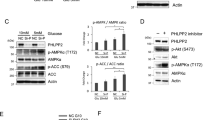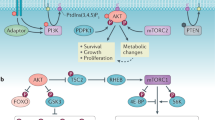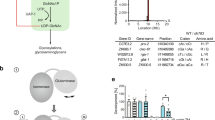Abstract
We have identified a novel mechanism of cross-talk between cell signaling and metabolic pathways, whereby the signaling kinase p21-activated kinase 1 (Pak1) binds to, phosphorylates and enhances the enzymatic activity of phosphoglucomutase 1 (PGM), an important regulatory enzyme in cellular glucose utilization and energy homeostasis. Pak1 and PGM were colocalized in model cell systems and showed functional interactions in a physiological setting. Strong direct interaction of PGM with Pak1 but not Pak2, Pak3, or Pak4 was observed. PGM binding was within 75–149 amino acids (aa) of Pak1, while Pak1 binding to PGM was in the N-terminal 96 aa. Pak1-mediated phosphorylation of PGM selectively on threonine 466 significantly increased PGM enzymatic activity and could be blocked by transfection with a dominant-negative Pak1 expression vector and by Pak1-specific small inhibitory RNA. Stable transfection of PGM into PGM-deficient K562 leukemia cells further demonstrated the role of Pak1 in regulating PGM activity. The results presented here provide new evidence that the cell signaling kinase Pak1 is a novel regulator of glucose metabolism through its phosphorylation and regulation of PGM activity. These findings suggest a new mechanism whereby growth factor signaling may coordinately integrate metabolic regulation with established signaling functions of cell cycle regulation and cell growth.
This is a preview of subscription content, access via your institution
Access options
Subscribe to this journal
Receive 50 print issues and online access
$259.00 per year
only $5.18 per issue
Buy this article
- Purchase on Springer Link
- Instant access to full article PDF
Prices may be subject to local taxes which are calculated during checkout








Similar content being viewed by others
References
Adam L, Vadlamudi R, Kondapaka SB, Chernoff J, Mendelsohn J and Kumar R . (1998). J. Biol. Chem., 273, 28238–28246.
Adam L, Vadlamudi RK, Mandal M, Chernoff J and Kumar R . (2000). J. Biol. Chem., 275, 12041–12050.
Bagheri-Yarmand R, Mandal M, Taludker AH, Wang RA, Vadlamudi RK, Kung HJ and Kumar R . (2001). J. Biol. Chem., 276, 29403–29409.
Barnes CJ, Li F, Mandal M, Yang Z, Sahin AA and Kumar R . (2002). Cancer Res., 62, 1251–1255.
Barnes CJ, Vadlamudi RK, Mishra SK, Jacobson RH, Li F and Kumar R . (2003). Nat. Struct. Biol., 3, 30–37.
Bokoch GM . (2003). Annu. Rev. Biochem., 72, 743–781.
Boros LG, Lee W-NP and Go VLW . (2002). Pancreas, 24, 26–33.
Danial NN, Gramm CF, Scorrano L, Zhang CY, Krauss S, Ranger AM, Datta SR, Greenberg ME, Licklider LJ, Lowell BB, Gygi SP and Korsmeyer SJ . (2003). Nature, 424, 952–956.
Dey NB, Bounelis P, Fritz TA, Bedwell DM and Marchase RB . (1994). J. Biol. Chem., 269, 27143–27148.
Gao H and Leary JA . (2004). Anal. Biochem., 329, 269–275.
Knaus UG, Morris S, Dong HJ, Chernoff J and Bokoch GM . (1995). Science, 269, 221–223.
Kumar R and Vadlamudi R . (2002). J. Cell Physiol., 193, 133–144.
Kumar R, Wang RA, Mazumdar A, Talukder AH, Mandal M, Yang Z, Bagheri-Yarmand R, Sahin A, Hortobagyi G, Adam L, Barnes CJ and Vadlamudi RK . (2002). Nature, 418, 654–657.
Lindahl M and Florencio FJ . (2003). Proc. Natl. Acad. Sci. USA, 100, 16107–16112.
Mazumdar A, Wang RA, Mishra SK, Adam L, Bagheri-Yarmand R, Mandal M, Vadlamudi RK and Kumar R . (2001). Nat. Cell Biol., 3, 30–37.
Meng TC, Fukada T and Tonks NK . (2002). Mol. Cell, 9, 387–399.
Putt W, Ives JH, Hollyoake M, Hopkinson DA, Whitehouse DB and Edwards YH . (1993). Biochem. J., 296, 417–422.
Schurmann A, Mooney AF, Sanders LC, Sells MA, Wang HG, Reed JC and Bokoch GM . (2000). Mol. Cell. Biol., 20, 453–461.
Shalom-Barak T and Knaus UG . (2002). J. Biol. Chem., 277, 40659–40665.
Shanmuganathan A, Avery SV, Willetts SA and Houghton JE . (2004). FEBS Lett., 556, 253–259.
Takahashi N, Omine H, Kaneko J, Miura A and Satoh C . Human Biol., (2001) 73, 755–762.
Tomkins J, Fox M, Lovegrove JU, Parrington J, Hopkinson DA and Whitehouse DB . (1997). Ann. Human Genet., 61, 99–108.
Unwin RD, Craven RA, Harnden P, Hanrahan S, Totty N, Knowles M, Eardley I, Selby PJ and Banks RE . (2003). Proteomics, 3, 1620–1632.
Vadlamudi RK, Adam L, Wang RA, Mandal M, Nguyen D, Sahin A, Chernoff J, Hung MC and Kumar R . (2000). J. Biol. Chem., 275, 36238–36244.
Vadlamudi RK, Li F, Adam L, Nguyen D, Ohta Y, Stossel TP and Kumar R . (2002). Nat. Cell Biol., 4, 681–690.
Warburg O . (1956). Science, 123, 309–314.
Zhai W and Comai L . (1999). Mol. Cell. Biol., 19, 2791–2802.
Acknowledgements
We thank Dr Richard B Marchase for providing a PGM antibody. This work was supported by the NIH grant CA 90970 and CA80066 (RK).
Author information
Authors and Affiliations
Corresponding author
Rights and permissions
About this article
Cite this article
Gururaj, A., Barnes, C., Vadlamudi, R. et al. Regulation of phosphoglucomutase 1 phosphorylation and activity by a signaling kinase. Oncogene 23, 8118–8127 (2004). https://doi.org/10.1038/sj.onc.1207969
Received:
Revised:
Accepted:
Published:
Issue Date:
DOI: https://doi.org/10.1038/sj.onc.1207969
Keywords
This article is cited by
-
A new insight into base excision repair (BER) in targeted cancer therapy
Genome Instability & Disease (2020)
-
The first evidence of global meat phosphoproteome changes in response to pre-slaughter stress
BMC Genomics (2019)
-
Transcriptome analysis in Malus halliana roots in response to iron deficiency reveals insight into sugar regulation
Molecular Genetics and Genomics (2018)
-
PAK4 regulates G6PD activity by p53 degradation involving colon cancer cell growth
Cell Death & Disease (2017)
-
Mutations in hereditary phosphoglucomutase 1 deficiency map to key regions of enzyme structure and function
Journal of Inherited Metabolic Disease (2015)



